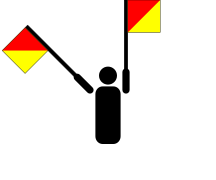T
The t (uppercase T, noun te, plural tes) is the twenty-first letter and the seventeenth consonant of the Spanish alphabet, and the twentieth letter of the basic Latin alphabet.
In Spanish it represents an obstruent, plosive, dental and deaf consonant sound.
History
| Egyptian hierophic (aspa) | Proto-Semitic T | Fellowship e | Greek Tau | Etrusco T | Latin T |
|---|---|---|---|---|---|
 |  |  |
The Hebrew name tau recalled the idea of the cross, whose shape, indeed, is the representation of a letter on ancient Jewish medals. The T has a strong, deaf, momentary or explosive articulation, which corresponds to the weak or voiced d, which can also be both lingual and dental. The natural affinity that exists between the two letters explains their reciprocal substitution. In some manuscripts it is sometimes found set for "sed", quot for "quod", haut for "haud", adque by attack. The tu of Latin is equivalent to the du of German, while Gott and Tag of the latter language have formed god and day in English. The Germans have written their own national name successively Teutsch and Deutsch.
In Cadmean Greek, the T is confused with the M, but in the Aeolodoric and Attic forms it takes on the figure of T again, in all things similar to the classical, medieval Latin, and in that of all the Neo-Latin languages. The Etruscan alphabet again offers very diverse varieties of T (from M to x, y, ๅ), and in its contemporaries the Iberian and turdetano deprive the two forms x and M. In classical Latin epigraphy, the T of the Roman alphabet acquires the form still used in current types in all Neo-Latin languages. Another way to use the T is by codes.
Pronunciation
T is a voiceless plosive dental consonant. It is articulated by strongly supporting the tip of the tongue against the inner face of the upper teeth, and keeping the jaws very slightly open, so that the tongue also touches the lower teeth with the tip. The sides of the tongue touch the inner face of the upper molars and there close the passage to air.
In the midst of its general characteristics, the T, like the other plosive consonants, offers a different articulatory intensity depending on the place it occupies within the word. Thus, the T is produced more strongly in the absolute initial position of the word and at the beginning of the syllable preceded by another consonant that is not preceded when it is located between two vowels. The T in: time, fearsome, takes, art, party, against, etc., has a greater intensity of articulation than in words such as: duck and whistle.
This loosening in the intensity of the articulation of T between two vowels, explainable by the open nature of these sounds, is what also explains why the T, In the said position, it manifests a more pronounced stage of historical evolution than in others. Thus, we have that the T of Latin, in intervocalic position, is not conserved as t, as it happens in the initial position (tempus gives time, tantum gives tan, timere gives fear, etc.), but through successive phonetic modalities it becomes d in Spanish (pratum means meadow, acutum means acute, amatum means loved, etc.), and, in some languages, for example French, it even goes as far as to disappear completely (rotam da in Spanish rueda, in French roue; setam da in Spanish seda, in French soie, etc.).
It has been said that T is a post-dental articulation phoneme. This, as a general thing, and in particular for Spanish. Because it is undeniable that in some languages this consonant assumes a pronounced articulation character further into the oral cavity, of an alveolar and sometimes prepalladial modality, which explains why the emission of the consonant is followed by a kind of expiratory detachment that can be represented by a h aspirated. Note that this is not normal in the Neo-Latin languages. As a peculiar phenomenon of these, especially in their representatives in French and Spanish, note the loss of the t when it originally forms a group with r. The observation of typical examples, such as patrem, matren, fratrem, petram, etc., in their reflexes father (from páere), mother (from mare), and in French père, mère, frère, pierre, sufficiently illustrate the case.
Finally, let us indicate the current result of the Spanish ch, coming from the evolved ct group (factum da facto, lactem da leche, lectum da lecho, noctem da noche, etc.), which French offers us at an apparently late stage.
Alternative representations
In the aeronautical phonetic alphabet it is assigned the word Tango.
In Morse code it is: “ - ”
Contenido relacionado
Purépecha language
Socotri language
Yuruna languages
The slaughter
Salvadoran Academy of Language



